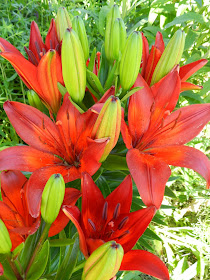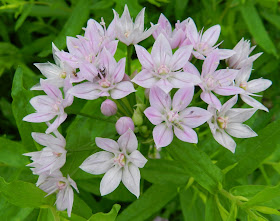"A thing of beauty is a joy forever," wrote the poet John Keats. However, gardeners know that is not necessarily so. While trees may last many lifetimes, the blooms of trees and other plants are usually fleeting. Nowhere was this more evident to me this spring than in my Baptisia. My lone Baptisia is in the roadside garden, and one day while working there, I noticed the first blooms on it and couldn't wait to see it covered in purple. A week went by before I thought of it again and realized I wanted to get a good photo of it this spring. But when I went down the lane with my camera, there were no blooms to be found!
 |
| These were the only Baptisia blooms I saw this year. |
Now you have to understand that this small flowerbed is at the end of our lane which is about 1/8 mile long, so I don't make a point of walking down to check things out every day. However, I do pass it every time I drive somewhere, so what happened? Was I just not paying attention as I left on errands, or did it even bloom fully? Sadly, I'll never know. But I have learned my lesson--even if you don't have time to work in it, pay attention to your garden every day, or you may miss something beautiful.
 |
| I almost pulled out this "weed"--which turned out to be a Rudbeckia! |
Recently fellow blogger Carol posted on Facebook that she was offering a course in weed identification: the workshop would be held in her garden, participants were to bring their own hoes, and the class would last until all the weeds were gone. Carol's post may have been tongue-in-cheek, but I really could use a course in weed i.d.--except, let's hold it in my garden, please! I can recognize dandelions, of course, along with bindweed, henbit, purslane, and the weedy grasses that are the bane of my garden, not to mention countless others whose names I don't know but whose appearance immediately tells me they must be banished at once. But there are so many plants I don't recognize as seedlings. I'm sure I'm not the only one who has nurtured a plant only to discover weeks later that it's a weed, or pulled a weed-lookalike, remembering later that I'm missing a new plant...unmarked, of course.
Actually, besides a course in weed identification, a good book on weeds would be an invaluable resource. One with clear color photos of mature weeds as well as the seedlings, with an easy-to-use cross reference of leaf size and shape. If such a book already exists, please tell me--I'll order it immediately!
On a positive note, I have finally learned the secret to growing annual poppies and larkspur. After several years with no success in growing poppies, I followed the advice of another blogger (sorry, I've forgotten who it was!) who recommended sowing poppy seed in late winter by sprinkling it over the melting snow in the garden. As the snow melts, the seeds sink down into the soil and germinate when they're ready. I've done this for several years now and have done the same with larkspur the past two years. Voila! Success! Next winter I'm going to get out my seed packets earlier and try the same technique with other annuals that require some cold stratification. Casting seeds out on the snow is certainly easier than filling my fridge with seed trays of 'Rocky Mountain Penstemon' and babying them for a few weeks as I did this spring, only to have nothing germinate.
 |
| The first of many poppies to come! |
 |
| This Nicotania escaped being pulled. A pretty white flower, but a few are enough! |
Last year I dug up and transplanted many of the 'Victoria' volunteers elsewhere, and I dug up dozens of Nicotania volunteers to give away. Not this year, which brings me to another important lesson I've learned this spring: sometimes you have to be ruthless in thinning out plants. I'm a saver by nature, and it's hard for me to throw perfectly good plants onto the compost pile, but really, sometimes you really can have too much of a good thing. I've pulled or hoed out most of the nicotania, leaving a few in an empty spot (and will probably be pulling more seedlings out as they pop up all summer!); I've hoed out the excess 'Victorias' that have strayed into the wrong territory; and, I've thinned out some of the poppies for now, and will be pulling most of them after they've bloomed, rather than leaving the seedheads. It's been a hard lesson to learn, but I know I will be so glad I did this as the garden fills in this summer.
 |
| Best friend Beckie, aka my "plant enabler," talked me into buying this basket, so of course I had to go shopping again to find some double impatiens to fill it! |
 |
| The largest of the Asiatic lilies, 'Brindisi' signals the beginning of summer and lily time! |
There will be more lessons learned in the garden through the rest of the year, more than enough to post some this fall, I'm sure. And that's a good thing--all this new knowledge helps to keep the old brain cells from atrophying. Besides, if I knew everything there was to know about gardening, it probably wouldn't be as much fun anymore!
Thanks to Beth for hosting this topic every season; you may learn something new yourself if you visit Plant Postings' wrap-up of lessons learned by other bloggers.




























